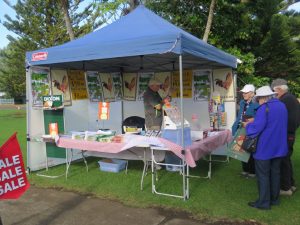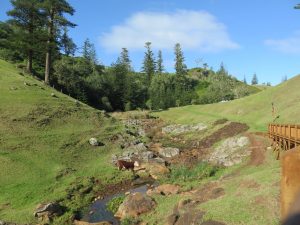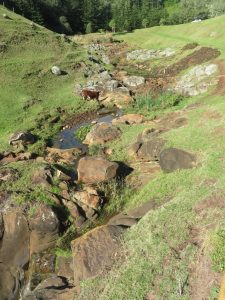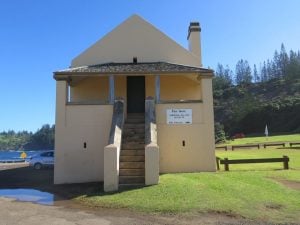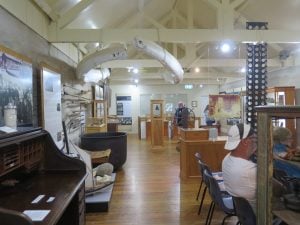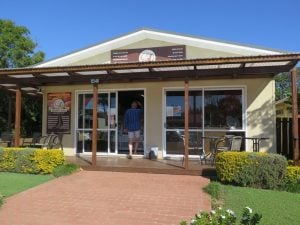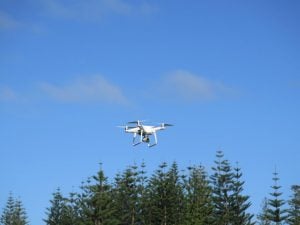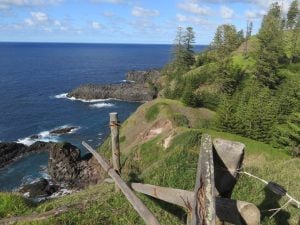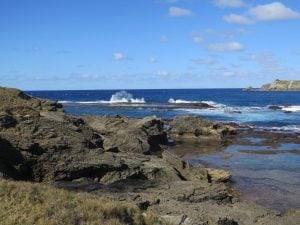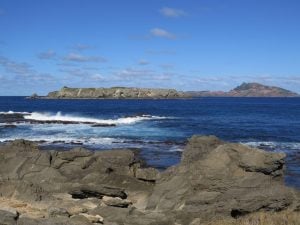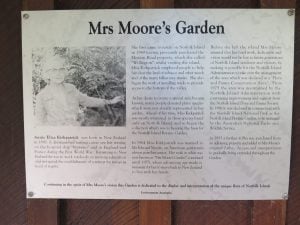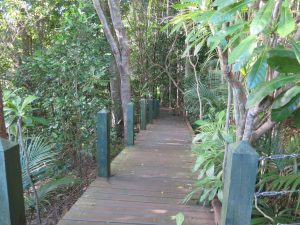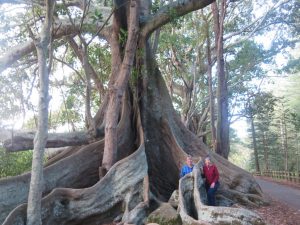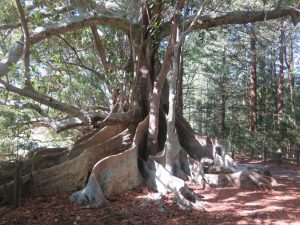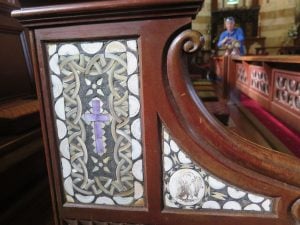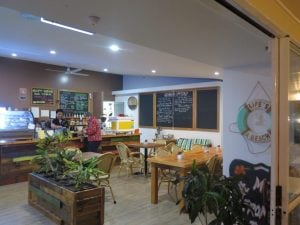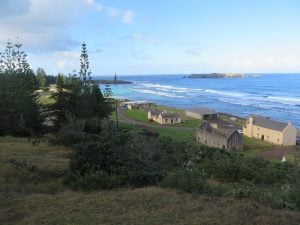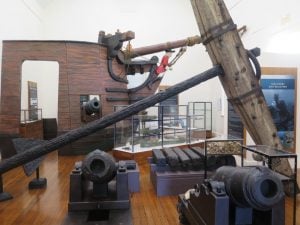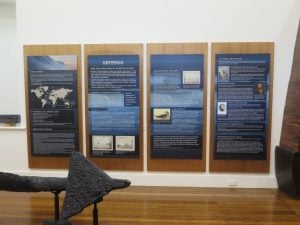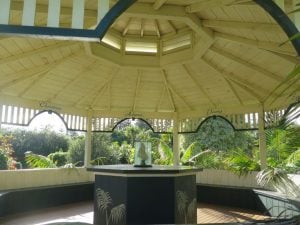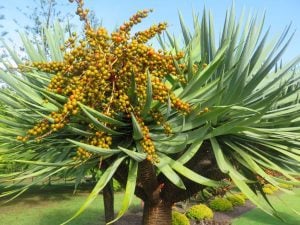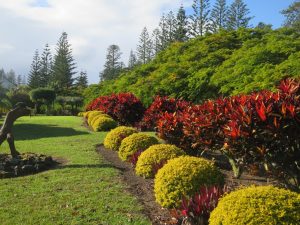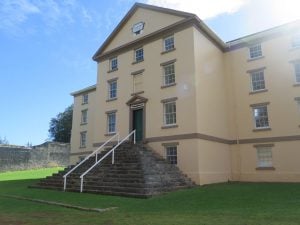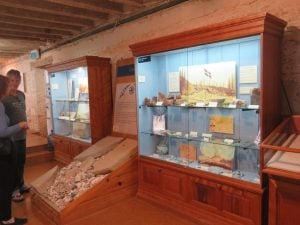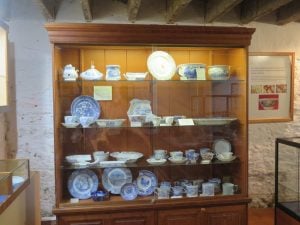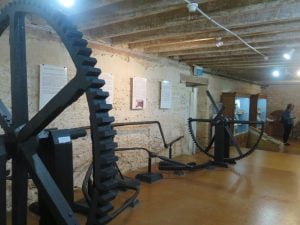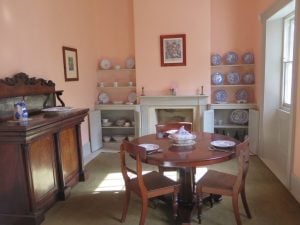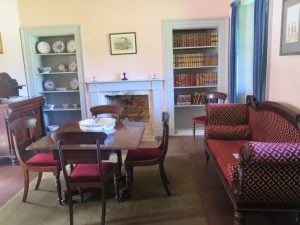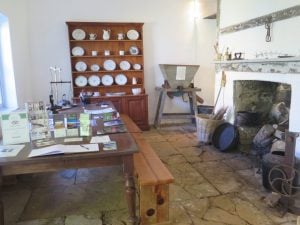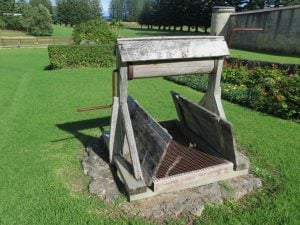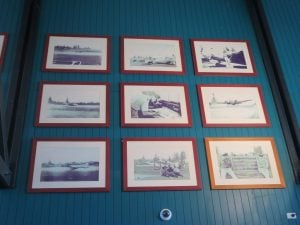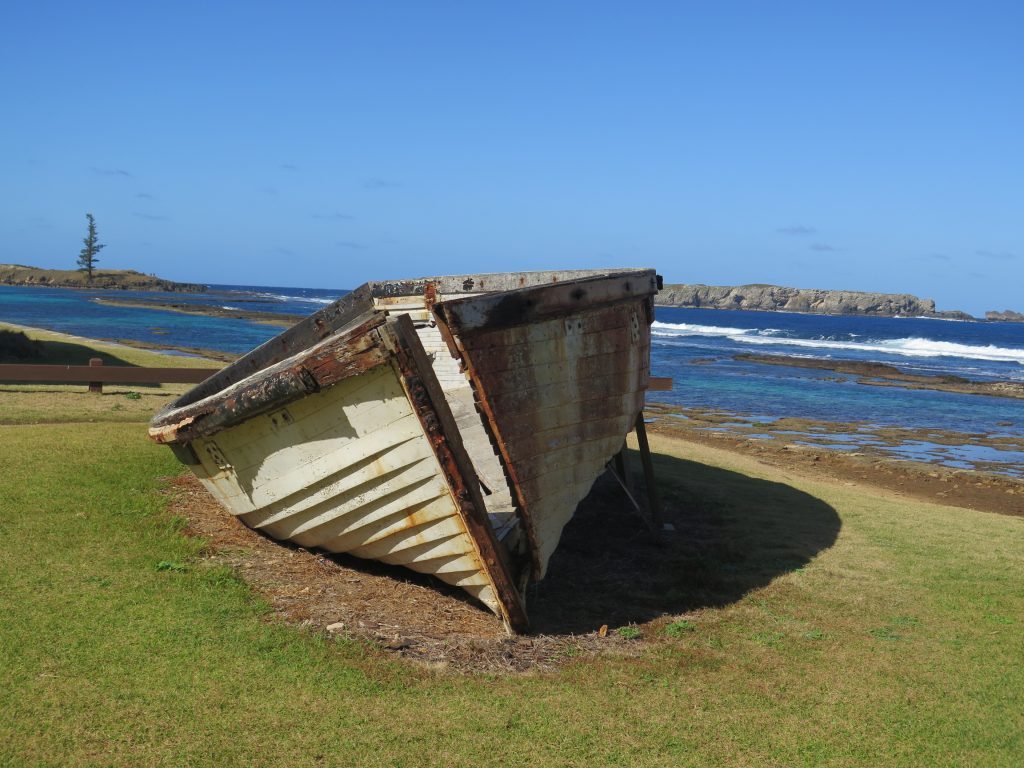View from Queen Elizabeth Lookout, heritage buildings in Quality Row in the foreground
Click on images to enlarge
16 June 2019
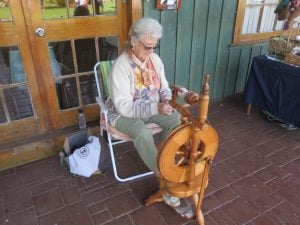 This morning it is Crafts Market time, not such an early start. There was some produce, but mainly crafts, an elderly lady spinning silk (sheep won’t be shorn for a while), a coffee cart, souvenirs, and a young girl selling home made goodies (below right) to raise money for her trip to Lake Macquarie this year with two other students from the local school – she was thrilled that we purchased some treats!
This morning it is Crafts Market time, not such an early start. There was some produce, but mainly crafts, an elderly lady spinning silk (sheep won’t be shorn for a while), a coffee cart, souvenirs, and a young girl selling home made goodies (below right) to raise money for her trip to Lake Macquarie this year with two other students from the local school – she was thrilled that we purchased some treats!
Steve bought himself a nice wooden pen (made from Norfolk pine), plus a 2020 Norfolk Island calendar for Gawaine.
Opposite the park is the Norfolk Art studio mainly with art from local meteorologist/artist Adam Jauczius, and I managed to find some nice hand made stud earrings for Tayla made by a young woman with connections to the Island. Steve has had some contact with Adam in relation to the Island’s weather and rainfall.
Steve was keen to revisit Cockpit Creek (right and below left) in the morning as he believed the sun would be in a better place than when we visited before, he wanted to send up the drone again. Very successful this time, he really loves this new toy.
It was a nice sunny morning, much better time for photographs than when we visited here last week.
Cascade Creek is one of Norfolk Island’s few permanent streams, along with its tributaries, its catchment area covers almost one fifth of the island and is an important home for native wetland flora and fauna. When it rains, high flows produce two main waterfalls, Cockpit Waterfall and Cascade Creek Falls.
Cockpit Waterfall is located inland, around 100 metres from the sea. Also known as Cockpit Falls and a popular destination for tourists, it is located within Cascade Reserve, an area of more than 30 hectares along the northern coast of Norfolk Island. Cascade Creek continues to flow past Cockpit, over the reddish-brown cliffs and into the beach at Cascade Bay, to produce Cascade Creek Falls
We also visited Ball Bay for the first time, a very beautiful spot on the eastern side of the Island (below left and right), and an ideal place for the the drone to have another fly, it is producing some fabulous panoramic footage as well as the more scientific data.
We had purchased some tickets to visit the various museums, the only one open today (Sunday) was the Pier Museum which focuses on the arrival of the Pitcairn Islanders, a beautifully presented museum and we learned a lot about those brave settlers.
This museum displays the current, or Third Settlement of people on Norfolk Island – the descendants of the Bounty mutineers. Downstairs the story begins with the 1789 mutiny on the Bounty and discovery of Pitcairn island by the mutineers. Life on Pitcairn and the eventual resettlement to Norfolk in 1856 is also covered.
Upstairs the displays continue to highlight aspects of Norfolk’s history and culture such as Anniversary (or Bounty Day), Melanesian Mission, Religion, Domestic Life, Industry and Agriculture, Whaling, Tourism and Education. Artefacts on display include historical weavings, items from the Melanesian Mission and whaling implements. There is also a display of Bounty Hats (below right), exclusive to Norfolk Island, and you can read the history of the hats here
Read more about The Pier Store here
Steve wanted to send up the drone again to take in the area of Kingston and over Emily Bay as it was such a perfect day. On the way home Steve tried a pie at the local bakery (below right, very tasty!) as we headed back for a rest. Later we returned to the Kingston area so Steve can use the Council office to update his drone images as we are still having problems with internet reception.
This evening we had another nice dinner at the Bowling Club, a very popular venue with locals and visitors alike.
17 June 2019
Today we drove to the east of the island to Two Chimneys Reserve, a large area with a steep walk down to a lookout with spectacular views over the ocean. In 1858-9 Governor Denison granted 50 acre lots to each of the Pitcairner families; other lands were retained as Crown Land for public purposes. On taking up their grants near the track to Point Blackbourne, the new settlers found ruins of two chimneys, apparently the remains of a Second Colonial (Penal) Settlement police hut. That track is named Two Chimneys Road on the 1860 Diagram of Allotments.
On the way back we stopped again at the Queen Elizabeth Lookout and the drone had another fly over the historic Kingston area, this caught the attention of two visitors from Townsville and we had a nice chat about our holidays, and of course they were interested to hear about the drone and its use. Just a short distance away was a property that has a huge old Banyan Tree that covers almost a whole paddock, which deserved a photo (right).
Next stop was the park area behind Emily Bay, Steve scheduled the drone to fly right along the waterfront and back to the park. After the drone had been airborne for a while, and we had lost sight and hearing of it, we became a little alarmed. Steve was able to use the GPS to find its location, then to send it back to “home” where it had taken off – it then did what it was instructed to do and landed back in the park where it started – big sighs all round as we were worried we might have lost it!
It was very low tide at Emily Bay (left) and along Slaughter Bay, Steve was keen to send the drone up again to photograph the immediate area, which also included Phillip Island and Nepean Island (off Emily Bay) so off it went again. I was able to get some great photos of Emily Bay and looking across the rocks toward the off shore islands (below left and right), and waves breaking along Slaughter Bay. The weather was perfect, again.
Our hard work, and lots of walking, meant we deserved a rest, so we headed for home. The Botanic Gardens are quite close to us, so during the afternoon we took the opportunity to visit this beautiful and peaceful place. A New Zealand woman, Annie Eliza Kirkpatrick, came to reside on Norfolk Island in 1949, and when her desire to create a special area became known, many people donated plant species which were not already represented in the garden. She was mainly interested in those species only found on the Island so she began the collection which was to become the basis for the Norfolk Island Botanic Garden. Boardwalks throughout the garden make it easier for wheelchairs etc to get around, and we enjoyed our time exploring the gardens and seeing some of the local birds.
An easy dinner tonight, scrambled eggs with bacon on toast, and some fresh zucchini and aubergine from the markets.
18 June 2019
Steve had been speaking to one of the locals yesterday, he said his father had purchased the property that had belonged to Nathanial Lucas and he directed us to the Bloody Bridge area. Although we had a good look at the area, we could not find the plaque that he said was there. So we headed off to The Olive Cafe for brunch, Steve had his usual ham, cheese and tomato toastie, and I ordered a toasted coconut bread with banana, passionfruit and cream – and we decided to share (I had carried on about how delicious the coconut bread combo had been at another visit!). The food and coffee did not disappoint! There was a young woman in the restaurant who saw me trying to connect to the internet with my tablet, and offered to help out if we went to her cafe (The Local) the following morning and we could use her computer. I was very grateful as I have been unable to access emails or bank accounts. We went for a browse at one of the duty free shops, Max, and found a nice shirt for Steve and a small handbag for Tayla.
We recalled that we had driven past the Giant Banyan Trees at 100 Acres Reserve and decided we would return there before we left to take some photographs. We were not sure of their location, but the local maps are very descriptive and we were able to locate them. I don’t know how old the trees are, but the root system is spectacular, and it is a popular spot for visitors to stop and take photographs. While we were there we met up with a couple from Melbourne and had a nice chat, they took photos of us among the roots of the trees, and we took photos of them. Shortly after two women came along to take photographs, and I was able to take photos of them too – a very popular spot!
We also wanted to return to St Barnabas Chapel to take some close up shots of the beautiful shell work, mainly at the ends of the pews. Luckily we arrived just before a few tourist buses, so we had a short time to ourselves to take the photographs, before the visitors poured into the church.
Hoping we could get some satisfaction with the internet, we returned to Norfolk Telecom for some assistance, but although Steve was successful (for a short time) in getting internet on his phone, there was little satisfaction out of the visit. Steve had some appointments during the afternoon with Council contacts in Kingston, so I had a nice quiet relaxed afternoon.
This evening we decided to get a takeaway dinner from the High Tide restaurant, very tasty curried beef, and chicken and bacon pasta with a salad – quite delicious!
19 June 2019
Steve had appointments again with Council contacts, so he dropped me off at Local Cafe with the intention that I could meet up with the lady who offered me the use of her computer, if I couldn’t connect with my own. There was nobody around at 9am (I think time means very little to the Islanders, lucky things!) so I wandered over to the supermarket and had a coffee in the cafe there. By the time I returned to Local (about 10am) someone was there, but I had to wait a while for the lady to arrive. I had no luck with my own computer, but was able to connect to my email and bank account on her computer – so limited success!
Steve soon arrived and we returned to the Kingston Heritage Area so Steve could organise his last drone circuit around Kingston, while I had a walk around the area where the first Government House was built (below left), went into the Surgeon’s Kitchen which is still standing (below right), then spotted a long stairway to Flagstaff Hill, and decided to walk up (bottom left). I probably was only half way up when I stopped at a lookout to take some more photos across the Kingston Pier area and along Slaughter Bay to Lone Pine near Emily Bay (bottom right), again on a lovely sunny day. The drone circuit was just finishing as I returned to drone “home base”, and had the opportunity to meet up with Murray from the Council.
View from Flagstaff Hill over Kingston Pier
Flagpoles (flagstaffs) have been erected on Norfolk Island at various times of settlement, the first one when Lieutenant King landed on 6 March 1788. They were removed when the settlement was abandoned in 1814 because they were conspicuous from the sea, and to prevent their use by passing ships or escaped convicts. The Pitcairners re-established the signal station and a new flagstaff was established part way up the hill by c1892. Prior to radio communication with ships, flags were used to give information about landing conditions, quarantine and safety. A white flag meant conditions were suitable to unload at Kingston. Red meant unloading was at Cascade. Red over white indicated unsuitable conditions at both jetties with the ship seeking shelter at Headstone, west of the island. If a yellow flag was flown on the ship it meant a doctor was required on board.
As we were running out of time we planned to finish our visits to the last two museums over the next day and a half. We returned to our cottage for some lunch, then headed to the HMS Sirius again in the heritage area. The journey of the First Fleet is celebrated in this museum. A touch-screen computer contains biographies of all who landed at Botany Bay in 1788 and a unique First Fleet Wall provides the opportunity to view the names of all those who made the journey. Descendants can purchase and have mounted on the Wall a timber disc engraved with their ancestor’s name and also sign a “Descendant’s Book” containing a page for each First Fleeter.
We were able to track Nathanial’s and Olivia’s names on the First Fleet Wall, and signed the relevant books to note our names and dates of our visit. This museum really made us think more deeply of life as it might have been when the First Fleeters arrived on Norfolk Island and the difficulties they must have faced in creating the first settlement.
Read more about the HMS Sirius here
We had enough time for our final visit to Mt Pitt for another drone circuit, then stopped by the supermarket to buy some Norfolk Island sausages to cook with the vegetables we had left over for a tasty dinner.
20 June 2019
Steve had an early appointment at the Council office to send documents to the Uni, then he collected me for our visit to the Queen Victoria Gardens. These beautiful gardens are dedicated to the memory of Queen Victoria who gave the island to the Pitcairn Islanders in 1856. The gardens are located on the family property of the late Marie Bailey (a descendant from the Bounty mutineers and their Tahitian wives). A qualified horticulturalist, Marie has amassed a wide collection of plant species from around the world and along with local native species has established a beautiful place to appreciate nature.
Inside the memorial rotunda, on the edge of the roof (above left) are noted the names of the descendants who apparently wrote to Queen Victoria inviting her to visit Norfolk Island.
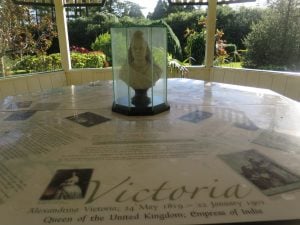
We had enough time to do another drone flight over Watermill Creek, get some petrol ($2.24 per litre) and for Steve to arrange postage of his sand samples to the Uni, then it was time to visit our last remaining museums (opened between 11am and 2pm).
Commissariat Store – with Marie Evans
The first was the Commissariat building where the stores were kept during the second convict settlement. The exhibitions here begin with the story of archaeological digs in the KAVHA area (Kingston and Arthur’s Vale Historic Area) together with the island’s fauna, flora and geology. The very first inhabitants on the island were the Polynesians and items including hearthstones and adzes recovered during digs in the area behind Emily Bay, help to tell the intriguing story of their time on the island.
However the main displays here are on the First and Second Settlements as they bring Norfolk’s convict past alive. Objects include glass beads and ceramic pieces from the First Settlement and whips, leg irons and crankwheels from the cruel Second Settlement. The extensive building program of the Second Settlement is covered with many stone, timber and metal objects. An 8 metre photographic montage of the Kingston area taken in 1867 really allows an appreciation of the extent of the buildings, barracks and gaol area that existed. Finally, the ceramics exhibition is a magnificent display covering an extensive range of makers, styles and production types.
Read more about the Commissariat building here
10 Quality Road – with Betty.
When this house was built in 1844 it was the height of the brutal Second Settlement. It has been restored to the period of its first inhabitant Thomas Seller, Foreman of the Works. Period furnishings show the house at it would have been for a gentleman living there with just his manservant, as Seller did (below left and right), servants’ quarters and well (bottom left and right).
Ceramics and other items that were recovered from archaeological digs in the privies are displayed, providing a unique opportunity to connect these objects with previous inhabitants. A display in the annex on the renovations and other inhabitants of the house, highlights the story of Isaac Christian and Miriam Young who with their 15 children lived in the house for 34 years from 1856. The grounds present a beautiful colonial period garden including a Common Red Hibiscus over 150 years old (above left), and a Norfolk Island hibiscus that has flowers of different colours on the one tree (above right and centre).
Read more about No. 10 Quality Road here
We had tried to organise a tour to Hilli Goat Farm situated at the north western tip of the Island near Anson Bay, but the Thursday tour had been cancelled. We were disappointed, but decided to visit the property which also contains the Norfolk Island Cottage Pottery and Gallery. Steve and Alison Ryves own and operate Cottage Pottery, producing high fired stoneware and porcelain. Steve is the potter, Alison paints and makes jewellery. Their work is exhibited in a gallery attached to the pottery.
Their daughter, Emily Ryves and her husband operate the Hilli Goat Farm and on their tours one sees the milking of the goats, a tour of the produce gardens, how the cheese is made, and a delightful lunch – maybe next time! The sign Turtle Bay caught my attention, one of Tim’s nicknames at the Bowling Club was “Turtle”.
Tonight is our last night on Norfolk Island and we decided to have dinner again at the Norfolk Island Bowling Club, because the meals are really good! Then some packing as we will need to vacate our cottage by 10am as tomorrow is “going home day”.
21 July 2019
Up nice and early today to finalise packing, making sure the cottage is clean and tidy, then driving to the Departure Lounge where we can leave our luggage until it is time for the bus to collect us for the airport. We had time for a final walk around the main shopping centre at Burnt Pine, and a coffee and snack at Olive Cafe (great coffee!). It had started to rain so we made our way back to the Departure Lounge for a relaxed half hour wait for the bus, and watching the rain really pelting down. I’m glad the rain waited until we were about to leave!
The Norfolk Island International Airport is the gateway to Norfolk Island for visitors and locals alike and is one the most important pieces of infrastructure on the island. The first runway was constructed on Norfolk Island with the assistance of the United States Air Force and the first aircraft to use it was a Lockheed Hudson bomber on the 25 December 1942. Today the Island receives five commercial operations per week from Sydney and Brisbane. The largest aircraft regularly utilising the Airport is presently the Airbus A320 and general aviation traffic equates an annual average of 2.5 arrivals a week. In addition to regular commercial flights the airport is crucial for medical evacuations to Australia. Photographs taken after the building of the airport and during the World War II are displayed in the Departure Lounge (below left and right).
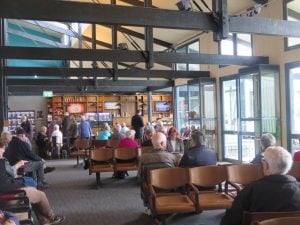 Getting through any airport is a pain, however we had a fairly trouble free time getting through customs etc and then we were on board our Air New Zealand flight. The Captain warned that it may be a little turbulent in some parts (it was probably about 10 minutes but seemed longer – I don’t like turbulence!) but otherwise the flight was good and we arrived at Sydney Airport at about 4pm. More pain getting out of the airport, but then a smooth train ride to Central Railway, and a short wait for our Newcastle train to take us on the last leg of our holiday trip.
Getting through any airport is a pain, however we had a fairly trouble free time getting through customs etc and then we were on board our Air New Zealand flight. The Captain warned that it may be a little turbulent in some parts (it was probably about 10 minutes but seemed longer – I don’t like turbulence!) but otherwise the flight was good and we arrived at Sydney Airport at about 4pm. More pain getting out of the airport, but then a smooth train ride to Central Railway, and a short wait for our Newcastle train to take us on the last leg of our holiday trip.
We really loved Norfolk Island (Steve thinks he would like to live there!), the pace is slow and stress-free, weather is pleasant all year round, inhabitants are friendly. The Island has such a great history, from very early visits from Polynesians, the First Fleet Settlers, the Second Fleet Convict Settlement and then the Pitcairn Islanders, making it a very interesting place to visit.
For those who may be interested in learning more about Nathanial Lucas, especially his life on Norfolk Island with his wife Olivia Gascoigne click here
and a letter Nathanial wrote to his father in 1796 and delivered in England by Phillip Gidley King when he returned to England on leaving Norfolk Island click here
Slaughter Bay with Lone Pine on the left, Nepean and Phillip Islands in the background


